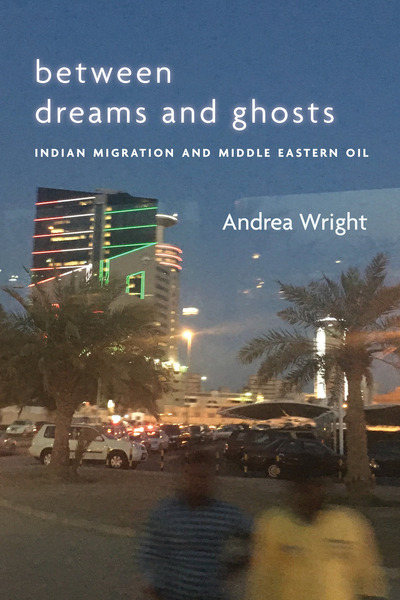
The secret behind oil as a commodity is labour, Andrea Wright reminds us. Between Dreams and Ghosts: Indian Migration and Middle Eastern Oil (published by Stanford University Press in 2021) is an anthro/historical study of the labour that drives the oil industry in the Arab Gulf. In the study spread over multiple locations and conducted over several years, Wright speaks and observes not just labourers but also recruiters, government officials and oil company managers, thus giving the readers a thick account of labour in the oil industry in the Arab Gulf. She meets them at the recruitment stage in Mumbai, at their workplace in the Gulf, and in their villages in India. Wright looks at the recruitment process, the expectations the recruiters have from the labourers, the labourer’s self-understanding of what is expected of them, life and labour in the oil rig constructions, the poetics of the labourer’s discourse regarding their place at home and in the nation, and finally the discourses on the two sides (labourers and employers) attached to mobility that fuel migration.
Migration from one nation to another is not a uniform process. For Gulf migrants, the bulk of whom are categorised as semi-skilled or unskilled by the government of India, the government finds itself in the role of the caretaker. Such caretaking involves on the one hand making sure that the labourers are not being exploited, and on the other, ensuring that the labourers are trained enough to represent the nation elsewhere. Wright observes the pivotal role of the recruitment agencies in India in meeting the multiple demands made on them by the different forces acting on them—the oil industry representatives, the governmental agencies, and the job aspirants themselves—in the process of being successful recruiters.
In the remote and isolated labour camps in the Gulf, the migrant labourers negotiate their absence from their home and their nation through poetics of metaphor and transubstantiation. In this poetics, the figure of the oil rig is transformed into that of a temple, and the gold to be given away at one’s sister’s marriage that one could afford only through one’s labour substitute for one’s physical presence at the ceremony. Thus, in occupying spaces in their spectrality, the migrants turn the images of the good citizen—which involves the metaphorical relay between temple and dam in the Nehruvian idiom, the connection between dam and modernity, and modernity as the sign of good citizenship which has been the legacy of tutelary nationalism of postcolonial India—as being realized at the oil rig in which the oil rig is the mandir/temple. Similarly, gold stands as evidence of the kinship material that the good dutiful son that the migrant labourer has been to his family provides to improve one’s social location, even though he has been physically missing from home.
In the last section of the book, Wright gives us contrasting notions of mobility. On the one hand, mobility is about freedom. The migrants characterise modernity as freedom and freedom with mobility. On the other hand, labour mobility in itself is one of how the system keeps the labourers precarious. Labour mobility, at the heart of which is a discourse of universal safe practices at the industrial workplace, is at the heart of the contractual labour system. The discourse of universality and homogeneity attached to safe practices turns the labourer into a movable chip in the workplace who can be contracted and subcontracted, moved across companies, and hired and let go at frequent intervals. The ubiquity of the safety discourse also often absolves companies from paying compensation for workplace injuries. Devoid of job security, the very mobility ironically makes the labourer a part of the mobile workforce who has to not just keep working but also keep looking for new opportunities in a perpetual state of insecurity.
The author debunks two widely held assumptions about migration to the Arab Gulf. The first of these is that of the kafala system as a remnant of the premodern practice in Arabia. Wright shows that in practice the kafala system is in line with neoliberal practices that govern labour relations in capitalism. The segregation of labour along national, ethnic and linguistic lines that is followed in the Gulf is a legacy of the securitization of the oil industry by British companies, and in reaction to the nationalisation of oil fields in Iran in the early 1950s and the strikes by Khaleeji workers in the 1960s. Thus, far from being something peculiar to the Arabs, it is caught up in the geopolitics of the region which involves the global imperial and capitalist forces.
The second frame of intellect that Wright asks us to think beyond is that of the individual migrant. The migrant is often thought of as an individual; migration is an individual experience. This individualization of the migrant is in line with the discourse of entrepreneur-migrant that characterises the statist account of migration, and the segregated contractual labourer that characterises the industry account. Wright however shows us that network is central to migration, right from recruiting to living in labour camps. The migrant is recruited through familiar networks, and it is through networks that the migrants try to offset, even though to a very limited extent, the precarity that is brought about by the neoliberal policies of the companies. In the process, the labourers do, once in a while, cross the barricades of the ethnic and linguistic segregation that marks their daily lives. The migrant is admonished if he starts thinking of himself as an individual, at times through corrective ghost stories, which I shall not spoil for you. The book is lucid and compelling, and a rich addition to the study of migrant labourers in the Arab Gulf.
***
Mohamed Shafeeq Karinkurayil teaches at Manipal Centre for Humanities, Manipal, India. His research focuses on labour migration from India to the Arab Gulf.
